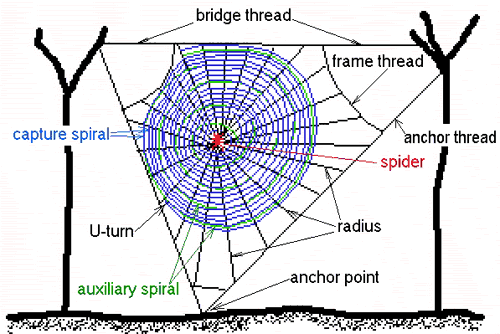
irst, the integral element of the web, the bridge line, is cast ~ the foundation for the entire lace patterned snare. Bear in mind that this filament must be well reinforced so that it can support the intricate and entwined yarn that will become the spider’s capture tool.

The marked feature of the bridge line and the rest of the entire web is its 3D construction. Yes, 3 D. The first "D" being, no, not divorce, but “duplicity”.
By definition,
Duplicity du·plic·i·ty (dū-plĭs'ĭ-tē, dyū-)n., pl. -ties.
1. Deliberate deceptiveness in behavior or speech.
2. The quality or state of being twofold or double.
3. Acting in bad faith; deception by pretending to entertain one set of intentions while acting under the influence of another
The state of being duplicitous, certainly in a close relationship, such as a marriage, or with a friendship involves the second “D” -
Deceit de·ceit (dĭ-sēt')n.
1. The act or practice of deceiving; deception.
2. A stratagem, ruse, or trick.
3. A misrepresentation made with the express intention of defrauding someone, which subsequently causes injury to that person. In order for a statement to be deceit, it must be untrue, made with knowledge of its falsity, or made in reckless disregard of the truth. The misrepresentation must be such that it causes harm to another individual.
None of the above can be achieved without the third element of this 3D construction.
Deliberation de·lib·er·a·tion (dĭ-lĭb'e-rā'shen)n.
1. A careful considering of a matter
2. The act or planning something carefully and intentionally
3. Careful, often cunning estimation and planning of likely outcomes, especially to advance one's own interests.
Deliberation, yes. The prime function of the web is to capture prey while conserving the predator’s energies. Much deliberation must go into web placement, design and effectiveness. Viscous filaments that have been extruded drift in the breeze and attach to a twig or branch a little distance away. Is anything in web positioning and fabrication left to chance? Not likely. In the event that natural drafts don’t carry the silk to the spider’s target, some will climb from the preferred vantage point unravelling the line making sure it does not snag on anything, then climb up another suitable structure to anchor the bridge line at a suitable spot.
By definition,
Duplicity du·plic·i·ty (dū-plĭs'ĭ-tē, dyū-)n., pl. -ties.
1. Deliberate deceptiveness in behavior or speech.
2. The quality or state of being twofold or double.
3. Acting in bad faith; deception by pretending to entertain one set of intentions while acting under the influence of another
The state of being duplicitous, certainly in a close relationship, such as a marriage, or with a friendship involves the second “D” -
Deceit de·ceit (dĭ-sēt')n.
1. The act or practice of deceiving; deception.
2. A stratagem, ruse, or trick.
3. A misrepresentation made with the express intention of defrauding someone, which subsequently causes injury to that person. In order for a statement to be deceit, it must be untrue, made with knowledge of its falsity, or made in reckless disregard of the truth. The misrepresentation must be such that it causes harm to another individual.
None of the above can be achieved without the third element of this 3D construction.
Deliberation de·lib·er·a·tion (dĭ-lĭb'e-rā'shen)n.
1. A careful considering of a matter
2. The act or planning something carefully and intentionally
3. Careful, often cunning estimation and planning of likely outcomes, especially to advance one's own interests.
Deliberation, yes. The prime function of the web is to capture prey while conserving the predator’s energies. Much deliberation must go into web placement, design and effectiveness. Viscous filaments that have been extruded drift in the breeze and attach to a twig or branch a little distance away. Is anything in web positioning and fabrication left to chance? Not likely. In the event that natural drafts don’t carry the silk to the spider’s target, some will climb from the preferred vantage point unravelling the line making sure it does not snag on anything, then climb up another suitable structure to anchor the bridge line at a suitable spot.

No comments:
Post a Comment